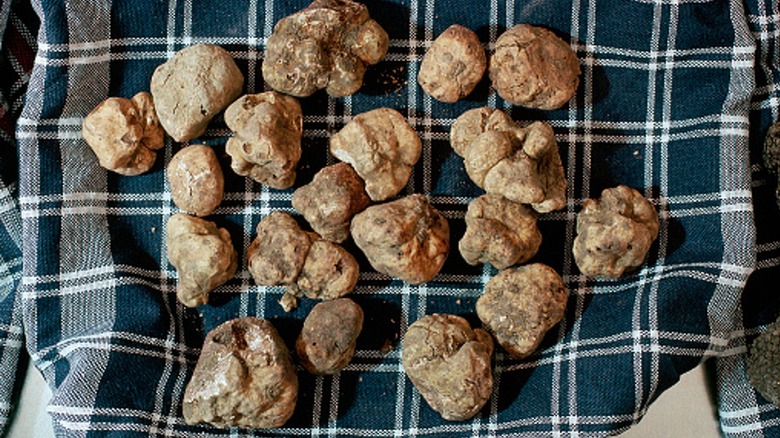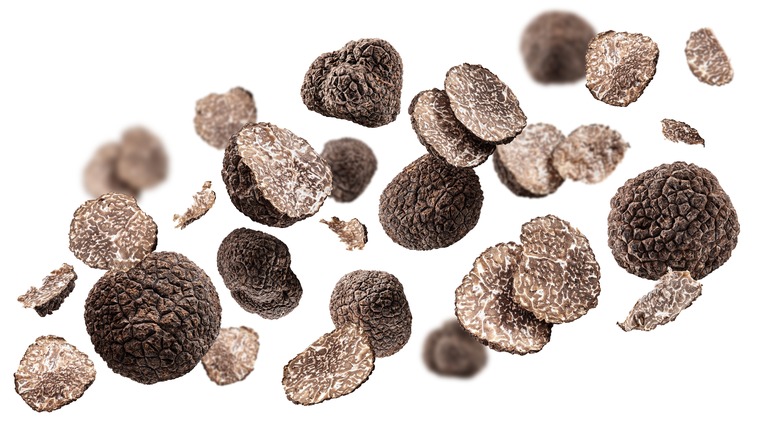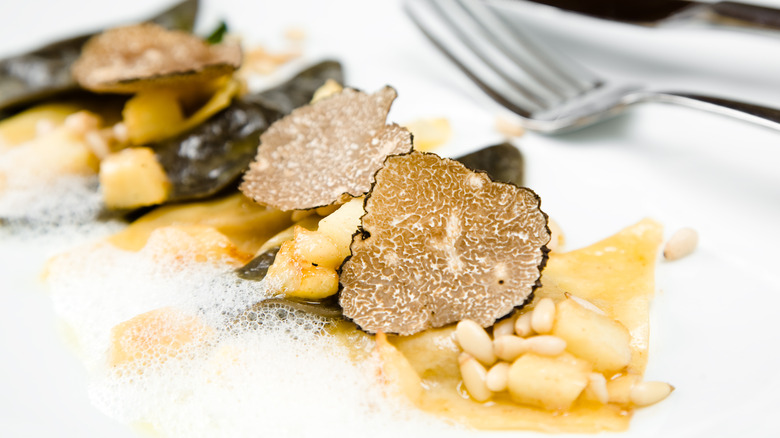Do Truffles Really Need To Cost So Much?
Once a little-known culinary treasure familiar only to chefs and gourmands, the mighty truffle has, for the most part, broken free of being exclusively for fine dining. It's true: Most people can now experience the flavor of the luxurious fungus infused into everything from oils to honey, but to sample fresh truffles is still mighty expensive. Black truffles can cost upwards of $1,800 per pound while white truffles from Alba in Italy can cost a staggering $7,000 per pound.
Prices like this often make people wonder if this is pure highway robbery or, indeed, if the cost is justified. That answer is highly subjective, but it's true that fresh truffles are a coveted rarity, which certainly drives up the price.
For the most part, truffles are seasonal, only grow in specific locations, are difficult or impossible to cultivate, can't be harvested without canine help, and have a very short shelf life. All these factors make them highly sought after and expensive. Fresh truffles are equated in the culinary world with things like foie gras, caviar (a sexy partner to potato chips), and kopi luwak coffee, leaving some wondering if experiencing their special and unique flavor is mere wishful thinking at worst or a bucket list item at best.
The difference is black and white
Even though there are over 140 varietals of truffles in the world, the two most sought after types are the Périgord black truffle and the Italian white Alba truffle. Périgord black truffles are grown in southwestern France from November through March underground near the bases of oak and hazelnut trees. Because they are subterranean and can't be seen with the naked eye, specially trained dogs seek the truffles out by scent, notifying their handlers when they've sensed one. The flavor has been described as earthy, musky, and garlicky.
Even more desired are white Alba truffles. While Périgord truffles can sometimes be cultivated, white truffles can only be produced in the wild, in a small region of northern Italy, making them valued at several thousands of dollars per pound. The harvesting season is also shorter, from September through December. White truffles are sometimes described as having more of a garlicky aroma, with hints of shallot or cocoa. They grow best near oak, poplar, and linden trees.
Both black and white truffles should be used or eaten as soon as possible, preferably not long after they are harvested, as their flavor diminishes quickly. You can order them from several websites if you can't get to France or Italy during the winter, but the rushed shipping time required to maintain pristine flavor also adds to the cost and value.
The best way to enjoy truffles
The last thing you want to do is ruin what you've spent big bucks on. To experience the best flavor from your truffle, don't cook it, but instead use it as a finishing touch to a dish. They're best served warm, which is why you often see restaurants shave them over things like risottos, pastas, and eggs. Truffles are usually sliced on special shaving tools, made specifically for the ingredient, but you can also use a fine microplane to do the same job. Aside from the aforementioned dishes, freshly shaved truffles are also excellent on steaks, seafood, mashed potatoes, and sauces.
As much as many of us would like to shave fresh truffles over our favorite carbs, the cost of fresh ones make the ingredient largely unattainable. Alternatively, there are many truffle-infused products on the market that can give you an idea of what the fresh stuff tastes like. Truffle butter is amazing slathered on roast chicken, used in macaroni and cheese, or melted and poured generously over popcorn. Truffle mayonnaise makes an excellent condiment for french fries or topped on a steak sandwich. Cheeses with truffle in them can permeate your tastebuds with the unparalleled flavor of these special fungi, and truffle honey is fantastic drizzled over white pizza, fried chicken, or blue cheese.


